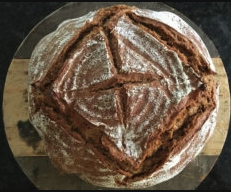Einkorn flour is certainly no stranger in my kitchen. I grind it fresh and use it in nearly every loaf of bread I bake. As the whole-wheat component for all artisan sourdough, I like the deeper, nuttier flavor it adds; but 100% einkorn sourdough is a whole other matter.
Einkorn Flour Has a Good Gluten
According to Jovial, "Einkorn has as much gluten as modern wheat, but it is free of the high molecular weight proteins that are hard to digest." But because einkorn gluten is different than modern wheat, the dough does not handle the same as other wheat flour. It usually makes a wet and hard to manage dough.
Kneading does it little good, as it tears apart rather than build the gluten strands we are familiar with in bread making. For that reason, many bakers add bread (strong) flour or vital gluten, both of which can ruin the value of this bread for those who are gluten-intolerant. Because water absorption with this grain is quite different, I suggest cutting water back to about 65% hydration during your learning curve; you can always add a bit more.
Baking Einkorn Bread

The third time for me was the charm
in making Einkorn bread
For this post, it took three tries before I was able to get the artisan look I was after. Don’t get me wrong, each loaf tasted great, but they didn’t look good enough to serve or to give away to someone else. But the third time it worked well for me.
When I began making sourdough bread, I was always on the lookout for lower gluten counts. That is when I found an Italian (Jovial) source of einkorn flour, which was superb flour, but it was milled in Italy and then shipped here. It has an appealing, creamy color and is sifted to an all-purpose grade of flour.
I figured that it could hardly have the same food value as freshly ground grain. And since it was expensive, I never tried making a 100% einkorn loaf from their flour—just a 50/50 mix, which was great every time.
Since then I have switched to buying whole-grain einkorn from Ancient Grains in Teton, Idaho. I mill it fresh and with 50 pounds of einkorn in storage, I figured that I had enough to do a few kitchen experiments.
NOTE: (Recently, Central Milling in Logan, UT and Petaluma, CA, started offering Einkorn Bread Flour. These folks supply the organic wheat berries and Artisan Bakers Craft Flour that we us at the Abigail's Oven Bakery.)
- For my first try, I just used our basic Country Loaf recipe with 100% einkorn freshly ground. This recipe calls for two cups of water and four cups of flour. The hydration was so high and the dough so overworked from my stand mixer, that I had to dump it into a bread pan to bake. It was dense, but toasted well and tasted great. Still, it wasn’t up to my standard.
- Then I found a recipe from Jovial’s cookbook, but I still ended up with too much water. The mix was a mess and I did not understand the tender nature of this flour so I overworked it again. I had to pour this dough into a bread tin once again. It was still great as a sandwich loaf, but I could not have shaped this and baked it as a boule.
- Then I came across this recipe at The Perfect Loaf and baked… well, the perfect loaf.

Einkorn Sourdough Bread Recipe
Adapted from Maurizio at The Perfect Loaf 70% Hydration
Ingredients |
Instructions |
Einkorn Sourdough Levain
|
Build the Levain
“In testing this formula, [Maurizio] found the best performance, taste, and timetable when using a stiff einkorn levain. Even though the flour I’m using is sifted (all-purpose) and not whole grain, this dough can quickly overproof at warmer temperatures. To offset this I found myself gravitating to a stiff levain at a very low pre-fermented flour percentage. Mostly, I treated this all-purpose flour as I would whole grain.”—The Perfect Loaf.
|
Dough
|
Einkorn Sourdough
|
Following this recipe from The Perfect Loaf finally helped me get a loaf of einkorn sourdough that I was happy with. I hope it works the first time for you.
In the comment section below share your thoughts and successes with einkorn.

Author: Darryl Alder lives with his wife in Riverside Lodge, which is their home along the Provo River in Utah. He is a retired career Scouter and outdoorsman who spent many hours over a campfire using a Dutch oven and loves sharing recipes for the kitchen and the campfire alike. You can read many of his recipes on this site by searching for Recipes on the top right-hand side of the blog.



3 comments
Thank you for the recipe. I have only been making sourdough bread for about a month or so and quickly moved to Einkorn with a mix of wholemeal strong flour…the results so far have been up and down so hopefully this recipe will help. Although I definitely, as a novice need to go an Google some terms, then come back and read again lol levain and autolyse…I think I know what they mean but they have just been explain in slightly more lay terms in other recipes lol consider me a lay reader 😂
Looking forward to trying this recipe put though, and I will come back and let you know how I got on, thank you again ✌️
Helpful Blog! Thanks for sharing.
I want to learn more about making sourdough bread with ancient flours.